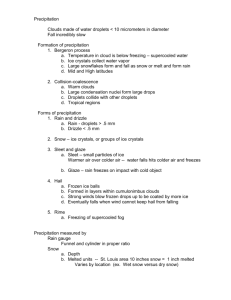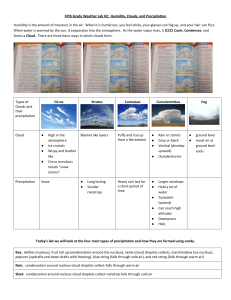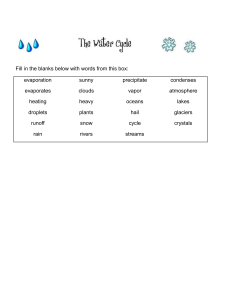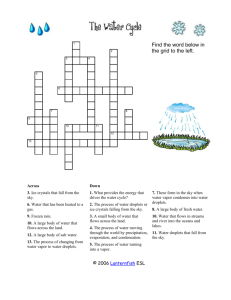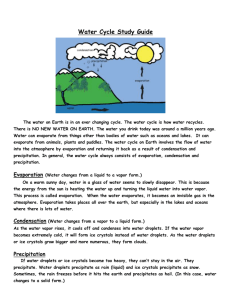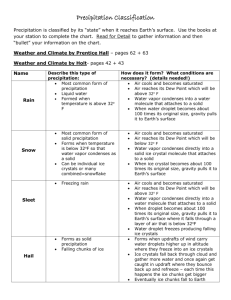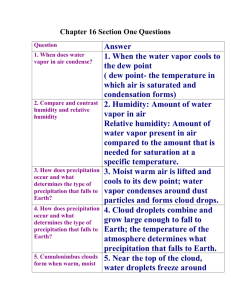Chapter 7 Precipitation Processes
advertisement
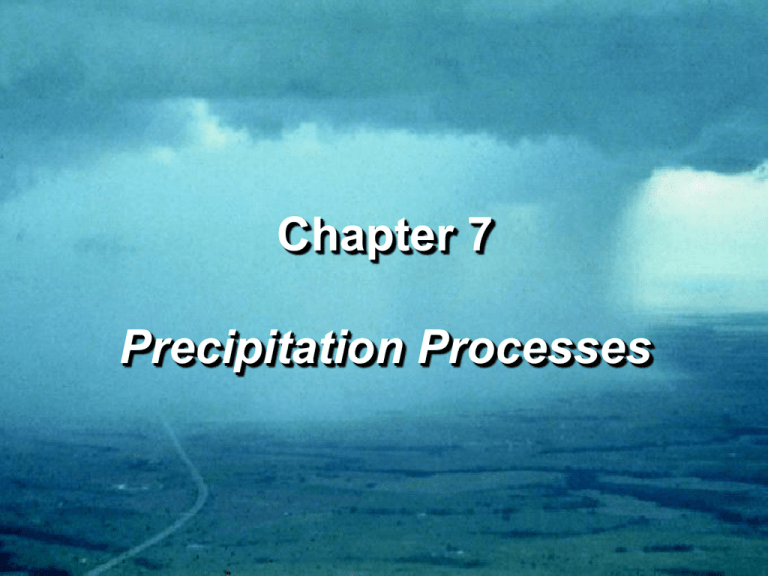
Chapter 7 Precipitation Processes Air exerts an opposing resistance to a falling object called drag. As speed increases, so does resistance, until its force equals that of gravity and the acceleration ceases. The object falls, but at a constant speed or terminal velocity. More than anything else, terminal velocity depends on size, with small objects falling much more slowly than large objects. Raindrops fall to the surface when they become large enough that gravity overcomes the effect of updrafts. In terms of radius, raindrops are about 100 times bigger than cloud droplets. Warm clouds are those having temperatures greater than 0 °C throughout. The largest droplet (collector drop) falls through a warm cloud and overtakes some of the smaller droplets because of its greater terminal velocity contributing to the collision– coalescence process. A collector drop collides with only some of the droplets in its path. The likelihood of a collision depends on both the absolute size of the collector and its size relative to the droplets below. If the collector drop is much larger than those below, the percentage of collisions (collision efficiency) will be low. As a collector drop falls (a), it compresses the air beneath it (b). This causes a pressure gradient to develop that pushes very small droplets out of its path (c). Small droplets get swept aside avoiding impact. When a collector drop and a smaller drop collide, they can either combine to form a single, larger droplet or bounce apart. Most often the colliding droplets stick together. This process is called coalescence, and the percentage of colliding droplets that join together is the coalescence efficiency. Because most collisions result in coalescence, coalescence efficiencies are often near 100 percent. Cold clouds (a) have temperatures below 0 °C throughout and consist entirely of ice crystals, supercooled droplets, and a mixture of the two. Cool clouds (b) have temperatures above 0 °C in the lower reaches and subfreezing conditions above. In the Bergeron process, if enough water vapor is in the air to keep a supercooled water droplet in equilibrium, more than enough moisture is present to keep an ice crystal in equilibrium. This causes deposition (i.e., the transfer of water vapor to ice) to exceed sublimation (i.e., the transfer of ice to water vapor), and the crystal grows in size (a). This, in turn, draws water vapor out of the air, causing the water droplet to undergo net evaporation (b). Evaporation from the droplet puts more water vapor into the air and facilitates further growth of the ice crystal (c). Although this is shown here as a sequence of discrete steps, the processes occur simultaneously. When ice crystals fall through a cloud and collide with supercooled droplets, the liquid water freezes onto them. This process, called riming (or accretion), causes rapid growth of the ice crystals, which further increases their fall speeds and promotes even further riming. Aggregation is the joining of two ice crystals to form a single, larger one. Aggregation occurs most easily when the ice crystals have a thin coating of liquid water to make them more “adhesive.” Snow results from the growth of ice crystals through deposition, riming, and aggregation. Ice crystals in clouds can have a wide variety of shapes, including six-sided plates, columns, solid or hollow needles, and complex dendrites with numerous long, narrow extensions. Rain is precipitation arriving at the surface in the form of liquid drops, usually between 0.5 and 5 mm. Episodic precipitation from rapidly developing cumuliform clouds is called showers and can occur as either rain or snow. Raindrops are not teardrop-shaped. They are initially spherical (a) but flatten out on the bottom as they fall (b). As they flatten, the greater surface area on the bottom causes greater resistance and further flattening (c). Eventually, the droplet breaks apart (d). Graupel occurs when an ice crystal takes on additional mass by riming and contains very small air bubbles that give it a spongy texture and milky-white appearance. Hail consists of ice pellets formed in roughly concentric layers. Updrafts carry a particle into the colder reaches of a cloud, and the liquid water coating the ice freezes. When the stone exits the updraft and falls, it becomes wet from its collisions with liquid droplets. The hailstone can be captured once again by an updraft, and the coating of water freezes. This process, when it occurs repeatedly, forms large hail. Sleet (above) occurs as rain falling from a cloud, passes through a cold layer, and freezes into ice pellets. This is most common along warm fronts. Freezing rain begins when a light rain or drizzle of supercooled drops falls through air with a temperature at or slightly below 0 °C. When the raindrops hit the surface, they form a thin film of water, but only for a moment. Soon afterward the water freezes to form a coating of ice. Global average annual precipitation. Rainfall is usually measured by a rain gauge. Standard gauges have collecting surfaces with diameters of 20.3 cm (8 in.). The precipitation funnels into a tube with one-tenth the surface area of the collector, so that the depth of water undergoes a tenfold increase. The precipitation level is measured by inserting a calibrated stick into the water, removing it, and noting the depth of the wet portion. An automated collector known as a tipping-bucket gauge provides a record of the timing and intensity of precipitation. Weighing-bucket rain gauges have a mechanism that translates the weight of the accumulated water in the gauge to a precipitation depth and stores the information automatically. Radar can measure the intensity of precipitation by emitting microwave radiation with wavelengths of several centimeters. Precipitating droplets, ice crystals, and hailstones can scatter the emitted radiation back to the radar unit. The more intense the backscattered radiation, the more intense the precipitation. The water equivalent of the snow, which is the depth of water that would result if all the snow were melted, can be roughly estimated using a conversion ratio of 10:1. Snow pillows are large air mattresses filled with an antifreeze liquid and connected to pressure recorders. As snow accumulates on a pillow, the increased weight is recorded and converted to a water equivalent. Cloud seeding involves injecting one of two materials into nonprecipitating clouds. The objective is to convert some of the supercooled droplets in a cool cloud to ice and cause precipitation. Dry ice (frozen carbon dioxide) promotes freezing because of its very low temperature. Silver iodide initiates the Bergeron process by acting as an ice nucleus. The next chapter examines atmospheric circulation and pressure distributions.
